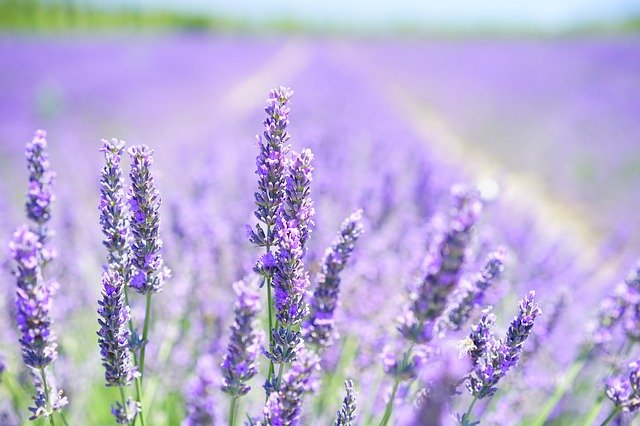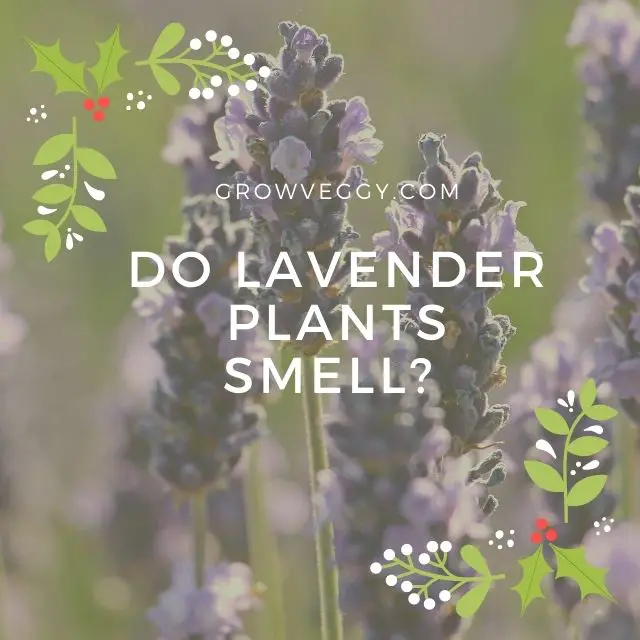When lavender plants are at their prime with a healthy bunch of flowers, the scent is strong and does not need an introduction.
Yes, lavender plants smell and have a distinct one that cannot be mimicked by any other scent.
You just have to smell lavender once to memorize the scent forever! But, only healthy and comfortable lavender plants will create such a strong smell.
Why doesn’t My Lavender Plant Smell?
Lavender flowers are known to bring about that smell we have all come to know as lavender.
In some variants, it’s not just the flowers that have this capability. In fact, every part of the foliage in some lavender plants is known to give off a typical lavender aroma.
But, this appealing smell is not guaranteed! Yes, that’s right! You have to ensure that your lavender has everything it needs to make oils and the fragrance accompanying the oils.
When conditions are not appropriate your lavender will stop producing fragrant oils and flowers.
The conditions that please a lavender plant are many and taking care of each one is vital for scent production.
- Watering should be kept to a minimum once every two weeks to avoid root rot.
- Sunlight (for at least 6 hours) is crucial!
- Soil should have low/medium nutrient levels and an alkaline pH between 6.5 and 7.5 is a must
- Choose the best and most fragrant lavender variant for your garden
- The smell of lavender is usually strongest in the growing season and most intense in the morning
Factors Influencing Intensity of Lavender Plants Smell
If you want lavender to produce its unique smell, you have to make sure the plant is first healthy and happy!
These plants are very sensitive and will sense the slightest anomaly in growing conditions and caring practices.
If you want to get the lavender fragrance in the air, take care of the following conditions.
1. Sunlight Strength and Intensity
Sunlight is a naturally important requirement that all lavenders require to grow and flower to their full potential. It enables them to synthesize growth raw materials.
This is probably the reason why lavenders thrive in the Mediterranean area (France, Italy, and Spain). All these countries are known to have high temperatures and sunshine throughout the year.
Sunlight influences the oil production of a lavender plant and hence it also determines the intensity of smell as well. Less sunlight means fewer oils and less fragrance production.
But, what if you don’t have a Mediterranean climate? That’s okay because you just need to provide 6 hours of sunlight to your lavender plants.
Making sure your lavender gets morning sunlight is most ideal as lavender oil concentration and production are highest in the morning.
If your lavender is not receiving enough sunlight, transplant it to another location that gets more early sunlight.
Alternatively, you can transplant your lavender to pots. This way, you can move them around and make sure they get the best sunlight throughout the day.
Planting lavender in pots has another advantage as well. You can bring them indoors during winter.
English lavenders are cold-hardy up to USDA 5. On the other hand, French and hybrid lavenders only have a tolerance up to USDA zones 7 to 9.
2. Over-fertile Soils Inhibit Lavender Smell
In its natural habitat lavenders grow in sandy soils that have poor quality and are lacking in nutrients.
Lavender has very minimal nutrient requirements and you should not overgrace them with too much organic matter or fertilizers.
Being acclimatized to these conditions, these plants actually do best in these poor-quality soils with high sand or gravel content. It is in these soils that they tend to produce more flowers and a stronger fragrance.
So it makes sense that a great deviation from such types of soil would affect lavenders, and particularly their smell!
Lavenders grown in excessively rich soils will not flower and will become leggy. Also, they may not produce a lavender scent, or at least not one that is impressive enough! They prefer soil with low to medium mineral value.
Contrary to what people think, the addition of fertilizers will not increase flower production!
Even worse, high nitrogen amounts can turn the color of your lavender leaves from green to yellow! It may turn the leaves another color so don’t be alarmed if your lavender turns gray.
The best option to keep your lavender plant smelling like pungent lavender is to amend your soil. Add more sand or gravel to make it less fertile and also more porous.
3. Overwatering Causes Root Rot
Overwatering is the leading cause of lavender plant death.
Lavenders are used in arid climates where water is not that frequently available. Watering of your lavender should happen only once in a two-week time span.
Anything more and it will have ill effects!
Watering your lavender too much will stress the plant. The excess water will accumulate in the soil and affect the roots.
This is when it will develop root rot. This condition leads to saturation and the roots will become soft and start to deteriorate.
If a lavender plant is too stressed it will not be able to produce flowers. In turn, this will affect the accompanying lavender fragrance that flowers are famous for.
A variety of conditions determine the frequency of watering your lavender plants. A few particular factors that influence watering requirements are the season, temperature, and location.
During winter watering has to be reduced as the plants won’t be growing. Instead, the plants will be in a dormant phase.
In this case, water lavender plants only every 4 to 6 weeks throughout the winter. Yes, you read that right!
4. Soil pH Affects Smell in Lavender Plants
Cases may arise when all lavender plant requirements are met but plants still lack the strong familiar smell of lavender.
If it has full sunlight, is watered every two weeks, and has appropriate soil, you should begin to suspect the soil pH.
Lavender cannot grow in overly acidic conditions. Mildly acidic to alkaline conditions stimulate growth and scent development.
Anything other than alkaline soil will not suit your lavender and not do anything to help or improve scent production.
If you want your lavender to thrive, an alkaline pH between 6.5 and 7.5 is best. Also, a neutral pH of 7 will not be that detrimental for your plants.
Lavender grown in acidic soils (pH less than 6.5) will not display optimal oil and fragrance production! So, making sure soil pH levels are ideal is vital to making lavender the fragrance.
Checking that soil pH is adequate for growing lavender should take place before planting them.
This is important because amending soil pH does not happen overnight. It takes a long time and you might want to transplant the lavender plants in the meantime.
Amending soil involves adding lime or wood ash to the mix or substituting the whole soil area.
Even then, only transplant or plant lavender in it after it has passed the pH range (6.5 – 7.5) repeatedly.

Varieties of Lavender Plants With Strong Smells
The scent of lavender creates a breath of fresh air that brings a calming effect to all who smell it.
Many people grow lavender in their homes or gardens mainly for their smell. There’s nothing wrong with wanting to have an aromatic garden!
There are certain lavender variants that are particularly prized for their more intense scent than other variants.
– Hidcote Lavender
A popular variant adored for its very purple flowers and greyish-green scented foliage is the Hidcote lavender variant.
The type of soil used to grow them could influence their size. Height ranges from 12 to 20 inches while width ranges from 24 to 30 inches.
The stems of this lavender plant are short and scented; making for a great garden edging plant option.
Constant pruning and deadheading can induce more frequent flowering. It can flower up to three times in ideal conditions!
This variant is appealing since the flowers retain their color and scent. This makes it exceptional for the culinary world.
If you want fragrant flowers from spring till the start of winter, Hidcote is the right lavender for you.
– Lavandula x intermedia ‘Grosso’
Having one of the strongest fragrances, the Grosso lavender variant is a hybrid lavender.
In fact, its flowers are so large that this plant has earned the name ‘fat lavender’!
The large flowers have richly colored violet flower spikes. But, its appeal is not all!
This lavender makes a good option for lavender sachets. Because of their ability to retain fragrance, color, and composure when dry, they keep well.
So, this makes them ideal for therapeutic reasons too.
Growing 24 to 36 inches in height, their silvery-green foliage is as appealing as its flowers.
This makes a great plant for planting along borders, paths, and mass planting in open areas. Removal of fading flowers can stimulate another bloom!
– Folgate Lavender
The English lavender ‘Folgate’ is an Award-winning lavender that is an early bloomer.
In addition to this, it has an impressively sweet fragrance. Because of these unique characteristics, it is the variant of choice for cut flower displays and ornamental gardening.
Examples of its use are hedges or decorative garden installations.
Its violet-blue flowers blend well with the evergreen foliage of the plant. Another reason for the widespread popularity of Folgate lavender is the ability to keep this lavender compact and neat.
This lavender has culinary purposes and is a good source of lavender oil which has a sweet and soft scent.
– Butterfly/Papillion Lavender (Lavandula pedunculata subsp. pedunculata)
This lavender also goes by the name of Butterfly lavender or Papillon lavender. Being a variant of French lavender, it is tall with very ‘showy’ flowers! Flower heads are deep plum purple with long light purple bracts.
Foliage is a mixture of gray and green and contrasts well against the backdrop of the flowers. They grow to 24 inches in height and are usually a bit bushier than other variants.
These flowers bloom almost year-round and beautify the garden very well. The most prized feature of Lavandula pedunculata subsp. pedunculata is their strong smell.
Conclusion
The conditions in which they grow will affect the smell of lavender plants.
Providing ideal conditions will increase flower and oil production, leading to strong lavender scents.
But if any condition is inadequate the lavender smell will be faint or even absent due to a lack of oil and flower production.
FAQs
Simply because the environmental conditions (soil, water, sunlight) are not optimal for the creation of oils and flowers.
Correct these factors and your lavender plant should start to smell like lavender again! Getting a strong-selling lavender variant won’t hurt either.
The strongest smelling lavender is Lavandula x intermedia ‘Grosso’ which is a hybrid variant of lavender. Its cross-breeding between English lavender and Portuguese lavender leads to a superior lavender with better cold hardiness and fragrance.

